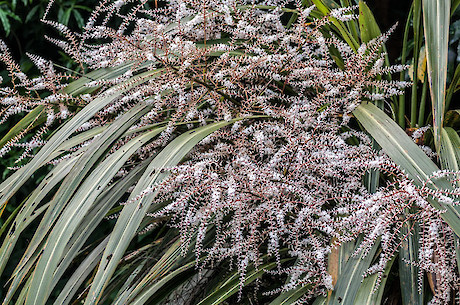 Cordyline banksii. Photographer: Jeremy RolfeVascular plants are called ‘vascular’ because they have a system of ‘tubes’ that connect all parts of the plant, roots, shoots and leaves, to transport water and nutrients from one part of the plant to another. These systems have evolved as vascular plants are typically large and therefore need special systems to connect the different parts of the plant.
Cordyline banksii. Photographer: Jeremy RolfeVascular plants are called ‘vascular’ because they have a system of ‘tubes’ that connect all parts of the plant, roots, shoots and leaves, to transport water and nutrients from one part of the plant to another. These systems have evolved as vascular plants are typically large and therefore need special systems to connect the different parts of the plant.
There are two separate transport systems, xylem and phloem, which are usually formed together in what are called vascular bundles. The xylem transports water and minerals from the roots to the other parts of the plant and is typically composed of tracheids, which are found in almost all vascular plants, and vessels, which are generally confined to the angiosperms. Both tracheids and vessels have very thick cell walls due to the deposition of lignin, which is deposited to strengthen the cell wall once the root or shoot has stopped elongating. In the vessels the transverse walls between the cells break down and this results in continuous, lignin-lined tubes than run from the root to the growing tip of the shoot. Tracheids, on the other hand, do not lose their transverse walls but the individual cells are connected by pores or more correctly, pits. Both of these cell types are dead once the thickening has been laid down. The cells of the phloem are live and do not have thickened cell walls but they also form continuous tubes with perforated end walls (sieve plates) between the individual cells. The phloem functions as the main food-conducting tissue though many other substances, such as plant growth regulators, are also transported by the phloem.
There are four main groups of vascular plants: the gymnosperms, the angiosperms, the ferns and the lycophytes. The veins that can be seen readily in the leaves of angiosperms are used as one feature to separate monocotyledonous plants, with parallel veins, from dicotyledonous plants that typically have net-like patterns of veins. In the gymnosperms and angiosperms, a ring of specialized cells that can divide almost indefinitely (the cambium) forms between the vascular bundles and concentric circles of xylem, on the inside of the cambium, and phloem, on the outside, are produced. The rate of formation is related to the growth cycle of the plants, more large xylem cells are produced in the spring and summer than in the winter and this gives rise to the annual rings that are seen in many types of wood, since wood is composed of the dead cells of the xylem.
For more information about vascular plants:
